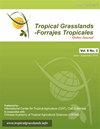农牧业如何影响坦桑尼亚塞伦盖蒂西部的牧草和土壤特性?
IF 0.7
4区 农林科学
Q3 AGRICULTURE, DAIRY & ANIMAL SCIENCE
引用次数: 2
摘要
研究了塞伦盖蒂西部不同土地利用方式下农牧活动对土壤性质、营养价值和草本植物剩余生物量的影响。植被和土壤样本分布在4000米的样带上,这些样带分布在休耕地、仅放牧牲畜的地区、混合放牧(牲畜和野生动物)和仅放牧野生动物的地区。在采样过程中,共发现123种植物。土壤和植被样本的分析在索科因农业大学实验室进行。在以牲畜为主的放牧地的样带上,放牧动物的平均密度估计为160 TLU/km,混合放牧为129 TLU/km,野生动物放牧为83 TLU/km。结果表明:不同土地利用类型对开花期残余牧草ADF、IVDMD、IVOMD、ME和TDN有显著影响(P<0.05),对CP、NDF和ADL无显著影响。土壤pH、OC、CEC、C:N和Ca在不同土地利用类型间差异显著(P<0.05)。综合评价表明,无论在何种气候条件下,塞伦盖蒂西部草本植物的剩余生物量与放牧强度、土壤C:N比和土壤Ca、P浓度有关。我们认为,在塞伦盖蒂西部进行的农牧实践影响了草本植物的剩余林分生物量和土壤性质。我们建议通过减少特定牧区的放牧动物数量或放牧时间来减少公共放牧地的放牧压力,并进行具体研究,以确定适合村庄特定公共放牧地的放养率。本文章由计算机程序翻译,如有差异,请以英文原文为准。
How does agro-pastoralism affect forage and soil properties in western Serengeti, Tanzania?
The impacts of agro-pastoral activities on soil properties, plus nutritive value and residual standing biomass of herbaceous plants in areas of different land uses in western Serengeti, were evaluated. Vegetation and soil were sampled along 4,000 m transects laid across fallow land, areas grazed only by livestock, mixed grazing (livestock and wildlife) and wildlife grazing only. A total number of 123 plant species were encountered during sampling. Analyses of soil and vegetation samples were conducted at Sokoine University of Agriculture laboratories. The estimated average density of grazing animals encountered was 160 TLU/km on transects within livestock-dominated grazing lands, 129 TLU/km for mixed grazing and 83 TLU/km for wildlife grazing only. Results indicated that ADF, IVDMD, IVOMD, ME and TDN in residual herbaceous forage at flowering were significantly (P<0.05) affected by land use type but CP, NDF and ADL were not affected. Soil pH, OC, CEC, C:N ratio and Ca differed significantly (P<0.05) between land use types. An overall evaluation indicated that regardless of climatic conditions, residual biomass of herbaceous plants in western Serengeti is determined by intensity of grazing, soil C:N ratio and concentrations of Ca and P in the soil. We conclude that agro-pastoral practices conducted in western Serengeti affected residual standing biomass of herbaceous plants and soil properties. We recommend that grazing pressure in communal grazing lands be reduced by either reducing number of grazing animals or duration of grazing in a particular grazing area, and specific studies be conducted to establish stocking rates appropriate for specific communal grazing lands in villages.
求助全文
通过发布文献求助,成功后即可免费获取论文全文。
去求助
来源期刊

Tropical Grasslands-Forrajes Tropicales
Agricultural and Biological Sciences-Agronomy and Crop Science
CiteScore
1.60
自引率
0.00%
发文量
36
审稿时长
16 weeks
期刊介绍:
The Journal publishes, in English or Spanish, Research Papers and Short Communications on research and development, as well as contributions from practitioners (Farmer Contributions) and Review Articles, related to pastures and forages in the tropics and subtropics. There is no regional focus; the information published should be of interest to a wide readership, encomprising researchers, academics, students, technicians, development workers and farmers.
In general, the focus of the Journal is more on sown (''improved'') pastures and forages than on rangeland-specific aspects of natural grasslands, but exceptions are possible (e.g. when a submission is relevant for a particularly broad readership in the pasture and forage science community).
The Journal will also consider the occasional publication of associated, but closely related, research in the form of an additional scientific communication platform [e.g. a re-make of the former Genetic Resources Communication series of the former Division of Tropical Crops and Pastures of the Commonwealth Scientific and Industrial Research Organisation (CSIRO), Australia].
Areas of particular interest to the Journal are:
Forage Genetic Resources and Livestock Production[...]
Environmental Functions of Forages[...]
Socio-economic Aspects[...]
Topics within the aforementioned areas may include: Diversity evaluation; Agronomy; Establishment (including fertilization); Management and utilization; Animal production; Nutritive value; Biotic stresses (pests and diseases, weeds); Abiotic stresses (soil fertility, water, temperature); Genetics and breeding; Biogeography and germplasm collections; Seed production; Ecology; Physiology; Rhizobiology (including BNF, BNI, mycorrhizae); Forage conservation; Economics; Multilocational experimentation; Modelling.
 求助内容:
求助内容: 应助结果提醒方式:
应助结果提醒方式:


